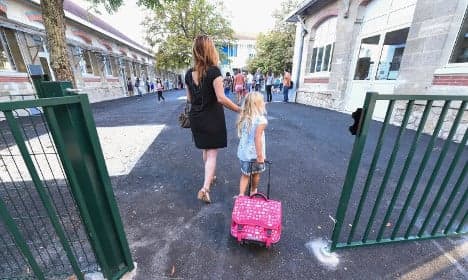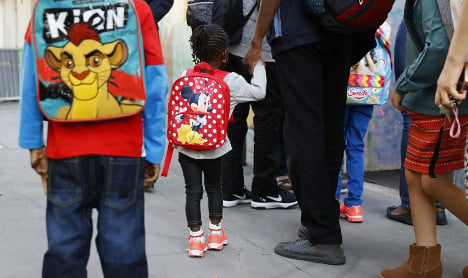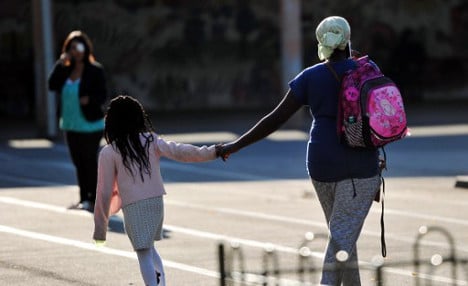The French schools system: The key numbers

As pupils return to classrooms across France here are some key figures that shed light on the French education system.
School children in France head back to class on Thursday, faced with a raft of new changes.
Here's a closer look in numbers at the state of French schools at the start of the new school year.
12.4 million
The total number of school kids this year. Of these, 6.81 million will be at primary school (école), 3.33 million at middle school (collèges), and 2.26 million at high school (lycée).
6,000 to 12,000
The average expenditure, in euros, for each student. This is broken down to €6,120 for those in primary school, €8,410 for middle schoolers, and from €11,190 to €12,230 for high schoolers.
861,000
The total number of teachers across the 63,600 schools in France.
 190.24
The average cost, in euros, of a getting equipment for going back to school. This includes things like books, paper, and sport uniforms, noted the organisation Familles de France.
42,338
The number of new jobs in schools created since 2012. This comes as part of the government's pledge to create 54,000 new teaching posts in state schools by 2017.
1,200
Teachers in elementary schools will see their ISAE allowance raised from €400 to €1,200 as part of the government’s efforts to boost teachers’ pay. This will match what teachers in primary schools get.
503
The number of new teachers starting in Seine-Saint-Denis, the department in the suburbs of Paris that will see the biggest increase in teaching staff this year. The area has been hit by chronic teacher shortages in recent years.
190.24
The average cost, in euros, of a getting equipment for going back to school. This includes things like books, paper, and sport uniforms, noted the organisation Familles de France.
42,338
The number of new jobs in schools created since 2012. This comes as part of the government's pledge to create 54,000 new teaching posts in state schools by 2017.
1,200
Teachers in elementary schools will see their ISAE allowance raised from €400 to €1,200 as part of the government’s efforts to boost teachers’ pay. This will match what teachers in primary schools get.
503
The number of new teachers starting in Seine-Saint-Denis, the department in the suburbs of Paris that will see the biggest increase in teaching staff this year. The area has been hit by chronic teacher shortages in recent years.
 3,911
The number of new teachers starting this semester. The number is made up of 3,411 full-time teachers, and 1,000 who are working half-time (making 3,911 in total).
25.5
The average number of children in a pre school classroom. There'll also be 23 per primary schoool class, 24.8 per middle school class, and 19.3 in each high school class.
363 to 396
The amount, in euros, that families can get in school allowances. Kids between six and ten are eligible for €363 per month, while those between 11 and 14 can get €383. Kids between 15 and 18 are eligible for €396 per month.
3,911
The number of new teachers starting this semester. The number is made up of 3,411 full-time teachers, and 1,000 who are working half-time (making 3,911 in total).
25.5
The average number of children in a pre school classroom. There'll also be 23 per primary schoool class, 24.8 per middle school class, and 19.3 in each high school class.
363 to 396
The amount, in euros, that families can get in school allowances. Kids between six and ten are eligible for €363 per month, while those between 11 and 14 can get €383. Kids between 15 and 18 are eligible for €396 per month.

Comments
See Also
School children in France head back to class on Thursday, faced with a raft of new changes.
Here's a closer look in numbers at the state of French schools at the start of the new school year.
12.4 million
The total number of school kids this year. Of these, 6.81 million will be at primary school (école), 3.33 million at middle school (collèges), and 2.26 million at high school (lycée).
6,000 to 12,000
The average expenditure, in euros, for each student. This is broken down to €6,120 for those in primary school, €8,410 for middle schoolers, and from €11,190 to €12,230 for high schoolers.
861,000
The total number of teachers across the 63,600 schools in France.

190.24
The average cost, in euros, of a getting equipment for going back to school. This includes things like books, paper, and sport uniforms, noted the organisation Familles de France.
42,338
The number of new jobs in schools created since 2012. This comes as part of the government's pledge to create 54,000 new teaching posts in state schools by 2017.
1,200
Teachers in elementary schools will see their ISAE allowance raised from €400 to €1,200 as part of the government’s efforts to boost teachers’ pay. This will match what teachers in primary schools get.
503
The number of new teachers starting in Seine-Saint-Denis, the department in the suburbs of Paris that will see the biggest increase in teaching staff this year. The area has been hit by chronic teacher shortages in recent years.

3,911
The number of new teachers starting this semester. The number is made up of 3,411 full-time teachers, and 1,000 who are working half-time (making 3,911 in total).
25.5
The average number of children in a pre school classroom. There'll also be 23 per primary schoool class, 24.8 per middle school class, and 19.3 in each high school class.
363 to 396
The amount, in euros, that families can get in school allowances. Kids between six and ten are eligible for €363 per month, while those between 11 and 14 can get €383. Kids between 15 and 18 are eligible for €396 per month.

Join the conversation in our comments section below. Share your own views and experience and if you have a question or suggestion for our journalists then email us at [email protected].
Please keep comments civil, constructive and on topic – and make sure to read our terms of use before getting involved.
Please log in here to leave a comment.